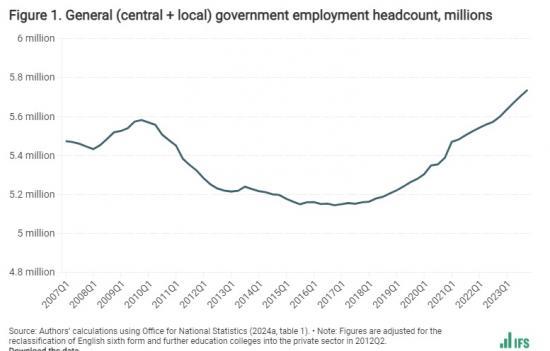Recent Trends In Public Sector Pay - How Has Public Sector Pay Changed In Recent Years? Which Type Of Workers Have Done Better And Which Have Done Worse?
27th March 2024

Pay for some public sector workers has risen much more than the economy-wide average in recent years. In particular, public sector workers on lower rates of pay have seen substantial, inflation-beating pay rises.
But higher earners have seen big reductions in pay in the public sector. At the 75th percentile (i.e. earning more than three-quarters of public sector workers), pay is now 8% lower in real terms than in 2007.
Teachers and doctors have faced bigger cuts still, with doctors particularly hard-hit over the period since 2019. Public sector pay deals that have consistently prioritised lower-paid workers mean that pay inequality between the private and public sectors has grown further. This is unlikely to be sustainable and is almost bound to lead to recruitment and retention problems.
Key findings
1. Average pay in the public and private sectors has performed very differently since the election in 2019. Real public sector earnings initially grew substantially during the pandemic (whereas private sector earnings fell as many were furloughed). But the ensuing rise in inflation hit public sector pay much harder due to government pay restraint. Overall, between December 2019 and November 2023, inflation-adjusted average private sector pay grew by 2.3%, whereas public sector pay fell by 0.3%.
2. These recent trends come on top of poor earnings performance in both sectors since 2007. Real public sector pay at the end of 2023 was still 1% lower than its level at the beginning of 2007. Real private sector pay increased by 4% from 2007 to 2023.
3. Within the public sector, some high-profile professions (nurses, and particularly teachers and hospital doctors) have seen considerably worse pay growth than the average public sector worker. Indeed,teachers saw large reductions in average real pay from 2010 to 2019 (falling 13%) but have seen stronger pay growth since then (with pay 5% higher in September 2023 than in April 2019 after accounting for the pay deals agreed last summer). Overall, this still leaves average teachers' pay in September 2023 9% lower than in 2010.
4. Looking at trends in the English NHS, nurses saw a significant reduction in real pay over the 2010s (falling 7% between 2010 and 2019) and only a modest recovery since, with average nurse pay growing by a little less than 1% over the same 2019-23 period. Doctors also saw pay cuts between 2010 and 2019 (of around 10%) but, unlike teachers and nurses, have also seen their pay fall further in the period since 2019, making them the hardest-hit group of the three.
5. Doctors and teachers, as higher-paid public sector workers, have felt the consequences of compression of public sector pay, with pay deals consistently benefiting lower-paid workers more than higher-paid workers both within and across professions. Compared with 2007, the real earnings of a public sector worker at the 75th percentile (i.e. earning more than 75% of public sector workers) had fallen by 8% by 2023, whereas for a lower-paid worker at the 25th percentile, real earnings had risen by 16%.
1. Introduction
With the large spike in inflation that has occurred since late 2021 and the associated cost-of-living crisis, there has understandably been intense interest in how workers' earnings have kept up (or not) with rising prices. This short report examines one aspect of earnings growth: how public sector earnings have performed in recent years, particularly focusing on the period since the 2019 election. We also examine earnings growth for major public sector occupations, how these trends differ from those seen in the private sector and how recent trends compare with the earlier period of public sector pay restraint that started in 2010.
Public sector pay is important not only for the living standards of the 5.7 million people who work for central or local government, but also for the delivery of public services and for the public finances. Total government spending on remuneration of public sector workers amounted to over £240 billion, or almost 10% of GDP, in 2022, with £178 billion paid in wages and salaries and a further £63 billion from employer National Insurance and pension contributions.1 As Figure 1 shows, following significant falls in the size of the public sector workforce between the end of 2009 and 2017, the number of people employed by government has increased significantly in recent years - rising by 460,000 (8.7%) since the time of the last election. This increase occurred both during the pandemic and more recently, with the headcount rising by 140,000 (2.4%) during 2023 alone. Figures from the Office for National Statistics (2024a) show that by far the biggest increase in headcount since the 2019 election was in the NHS, where it rose by 280,000, but there were also rises of 130,000 in public administration and almost 30,000 in the police.
Read the full IFS report HERE
Pdf download - 19 Pages
